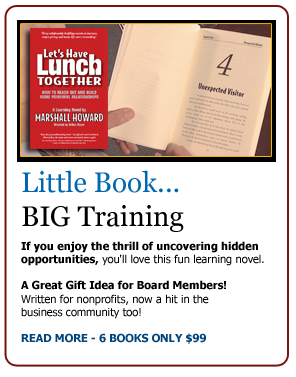Case Study:a great example of how relationships 
|
From The Lips of GrantmakersRecently, Marshall Howard delivered a keynote address at the KPM Philanthropy Summit in Boston for nonprofits and grantmakers. One outspoken admission: "I fund people, not programs," said Henry L. Berman, co-trustee of The Edith Glick Shoolman Children's Foundation. "Probably 50% of my grant-making decision is based on the people involved," he said "I'd rather fund a good program run by dynamic people, then fund a dynamic program run by mediocre people. People will outlast a program and they will make it successful." The foundation he helps run, The Edith Glick Shoolman Children's Foundation, supports programs that encourage early childhood literacy and well being for children from birth through the elementary years in the New York City metropolitan area and southeastern Massachusetts. Here's why he says yes:"I don't have a long list of specific metrics or a formal rubric where I assign points for each attribute in the grant application. But I do consider the people involved. We try to visit programs and meet with the appropriate people in the organization. Often two of us visit so we have a second set of eyes and ears. We look far beyond the facts and figures on a site visit. Each step or piece of the process is like a snapshot: the paper application, the financials, the site visit, conversations and correspondences. Together they comprise an album of images that collectively tell a story." "I realize people are often walking on eggshells when we do a site visit because we hold the purse strings," Berman said. "When we talk to the Executive Director, the program staff or teachers, we try to get the whole picture. Is the organization working together? Are they firing on all cylinders? It's rare that we ever meet the Board Chair or a Trustee but I'll bet I could give their speech." Relationships Matter! A few years ago, Berman made a one-time distribution of medical and educational grants from another trust and 80 - 85% of the money went to organizations, "where a key person was involved - one who was nice to me when they didn't have to be." "For instance, a decade earlier my former dentist networked me to his clients, introduced me to many people in the community and was an amazing supporter! Years later, long after he moved away to teach at a dental school and I had this trust to distribute, I called him at his new position and asked him how a grant could help the university and his students. Of course, it had to fit the criteria of the trust but he was at the top of my list because we had forged a relationship." How to Forge A Relationship with Grantmakers "It's a fine line between staying on our radar while not being a dive bomber. It has to be based on an understanding and respect for what we do. Just like Oscar, in Marshall's book, it's a slow building process. I'm happy to chat with applicants and answer their questions as best I can, but I'm not thrilled when flooded with emails and newsletters that are repetitive or only tangentially related to the program" Berman counseled. Six Ways to Connect with a Funder
Henry L. Berman spent the first 30+ years of his career as a writer/director/producer of films and video for education, training, motivation, and fund raising. He holds a B.S. in Communications from Ithaca College, both a Masters and Doctorate in Education from Boston University, and completed a certificate program at Harvard University concentrating in non-profit management. He has served on several non-profit boards, taking leadership roles in fund raising, strategic planning, governance issues, team building, and communication policy making. Currently he is the President and Co-trustee of the Edith Glick Shoolman Children's Foundation. 
Relationship Strategies That
|







